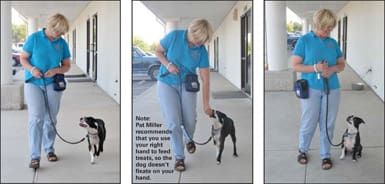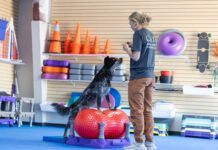One of the more frustrating experiences for positive dog trainers is watching their clients being dragged by their dogs across the parking lot toward their cars, just moments after training class is dismissed. “Dang,” we sometimes think, “Will they ever teach their dogs to walk politely on-leash? What part of ‘Don’t reinforce your dog for pulling!’ didn’t they hear?”
Of course, it’s equally frustrating for dog owners when their dogs drag them. And the training solution – stopping every time the dog pulls – gets tiresome. Owners often wonder if they will ever be able to go anywhere without handfuls of dog treats in their pockets. In some cases, owners are actually injured when their dogs yank on their arms, or even pull them off their feet. Many dogs have their social outings severely restricted, simply because their owners have difficulty controlling them on-leash.

288
If none of us want dogs to pull, then why is it that so many dogs do pull? There are several reasons:
- Their humans haven’t managed to reinforce polite leash walking strongly enough to overcome the high-value competing reinforcers in their dogs’ environments.
- Pulling is sometimes reinforced (by allowing the dog to go where he wants when he pulls) and behaviors that are intermittently reinforced become very durable/resistant to extinction (it’s hard to make then go away).
- Dogs are confused by owners who sometimes want their dogs to walk in perfect heel position, and sometimes let their dogs wander, sniff, and yes, pull.
- It’s just not a natural behavior. Unlike sit, down, touch, jump, and many of the other behaviors we put on cue, dogs rarely plod sedately along in a straight line of their own accord. Since it’s not a behavior that comes naturally to them, we have to work hard to make it reinforcing and convince them it’s a behavior worth offering.
Avoidance behavior
Training your dog to walk politely on-leash used to be so simple, some folks say. When he stepped out of position you simply yanked, hard, on his choke or prong collar. He learned to march lock-step next to you to avoid being garroted, and all was well.
Only it wasn’t that simple. I used to train the “old” way, and we still had plenty of owners dragged across the parking lot by their dogs after class. Besides, dogs get hurt that way.
Some of the same owners who are inconsistent about reinforcement now were just as inconsistent about punishment then. Others were (rightfully) horrified at the prospect of yanking on their dogs’ necks hard enough to suppress natural sniffing and pulling behaviors, and they just ignored our instructions to “jerk harder!”
At any rate, many dogs who were “trained” to walk politely on-leash were really only trained to avoid the punishment of the collar, which is why dogs still wore their choke chains in the obedience competition ring (many still do) as a not-so-subtle reminder of what could happen if they stepped out of line. This, despite the American Kennel Club’s odd pretense that you’re not allowed to use “training equipment” in the ring. What is a choke chain if not training equipment? And we all know dog owners who still walk their dogs in prong collars months – even years – after completing old-fashioned training classes. The dog didn’t really learn how to walk politely on-leash; it’s just avoidance behavior; he doesn’t want those prongs to dig into his neck!
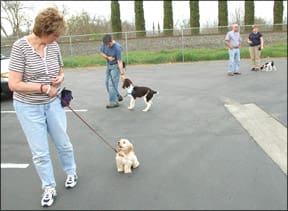
288
A partnership
Trainers and owners who subscribe to a positive approach to training are committed to making the process a partnership, with the dog willingly and happily participating in the behaviors asked of him. The exact opposite of the avoidance model, positive training asks the dog to voluntarily choose to offer the behavior so we can reinforce him for his choice.
The less natural and more complicated the behavior, the more practice – and reinforcement – the dog needs, to make the behavior a well-conditioned habit. Failures of leash training are most often a function of insufficient amount and value of reinforcement, lack of commitment to the necessary amount of practice, and impatience (increasing distraction and decreasing reinforcement too quickly).
Attention!
Realize that attention and focus behaviors are a hugely important piece of polite leash walking, and ones that you can practice with your dog separately from the actual leash-walking part. (See “Look at Me,” February 2004.) If your dog is paying attention to you, he’s not trying to sniff the bush you’re passing. You can practice attention exercises with your dog any place, any time, simply by reinforcing him with treats, attention, or a favorite toy any time he voluntarily glances your way. Shape for longer duration of attention by very gradually (a second or two increase at a time) waiting a little longer before you reinforce him for looking at you.
To get your dog’s attention when he hasn’t offered it voluntarily, teach him that a “Look at me!” cue is followed by a high value reinforcer. Say “Watch!” or whatever you want your cue to be, and feed a piece of something very tasty. When he has made a strong classical association with the cue (“Watch!” makes chicken happen!) you will be able to use your “Watch” cue to get his attention, even if he’s on-leash and distracted by a scent, a scampering squirrel, or the sight of another dog.
Age differences
Of course, polite walking lessons are best taught in puppyhood, before your baby dog has the opportunity to be repeatedly reinforced for pulling. Most young puppies naturally cling to the heels of their humans because they’re not confident enough to explore the world on their own. Start reinforcing this wonderful behavior early and often, and you build a foundation of a polite walking behavior that will make future leash training much easier for you. Your pup doesn’t even have to be on-leash for you to reinforce him for walking with you; just convince him from day one that being close to you while you walk makes very good things happen.
Once again, this proves the value of enrolling your puppy in a good, positive puppy training class as soon as possible. Sometime between the age of eight weeks and 16 weeks your pup will likely get bolder, and more willing to leave you to investigate his surroundings. A well-run positive puppy class is the ideal controlled environment in which to be able to reinforce him for walking with you even when there’s really interesting stuff nearby – like other puppies and humans.
When choke chains were de rigueur, training classes didn’t take puppies until the age of early adolescence, at six months, in part due to the potential for damage to tender puppy tracheas from enthusiastic jerks on the leash. With the advent of gentler training methods it has become perfectly safe – and appropriate – to start puppies in class at the age of eight weeks, as long as they are kept current on vaccinations throughout the class.
If it’s too late to start early, it’s still not too late to teach your dog polite leash-walking. It just means you’ll need more diligence and commitment to the training process to convince your adult dog that pulling on the leash no longer pays off. You will likely experience more and stronger pulling; you may need higher-value reinforcers and a higher rate of reinforcement; and you will probably find your dog reverting to pulling behavior more easily around novel or highly rewarding stimuli.
When you replace an existing unwanted behavior (pulling) with an incompatible one (walking politely) the original behavior never completely goes away (extinguishes). It lurks silently in the background, waiting for an opportunity to be triggered again (what’s called a “spontaneous recovery”). If that happens, you have to do the work, again, to prevent reinforcement for the pulling, and to reinforce the incompatible behavior that you prefer in its place.
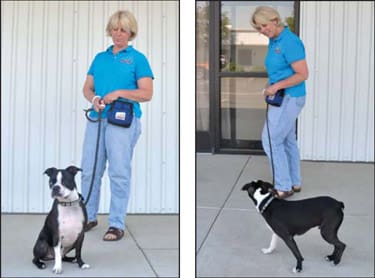
375
If you’re prompt and consistent about it, pulling should extinguish again with relative ease. If you’re inconsistent – if you sometimes reinforce pulling by allowing the dog to move forward with a tight leash – it’s even harder to extinguish pulling behavior. Trainers actually put some behaviors on an “intermittent schedule of reinforcement” in order to make them very “durable” (resistant to extinction). On an intermittent schedule, your dog learns if he just does the behavior often enough, like playing a slot machine, eventually the reinforcement will come.
Separate but equal
Does this mean your dog always has to walk in step by your side, never looking to the right or left? Not at all. You can teach your dog two different leash-walking behaviors; you just have to use two different cues, being clear about which behavior you reinforce at any given time, and making sure neither one involves reinforcing your dog for pulling.
For my dogs, “Heel!” means, “Do that pretty obedience walking where you prance by my left side, gaze adoringly into my eyes and sit with your shoulder by my left knee when I stop.” “Let’s walk!” means “We’re heading in the same direction and you can wander and sniff a little as long as you don’t pull.” That way, we can go on some walks in tune with my agenda: get from Point A to Point B in the most efficient manner; and some that are in tune with my dog’s agenda: taking time to stop and smell the pee-mail.
How do you teach your dog to walk politely? First, have a clear mental image of the behavior you want. Second, prevent your dog from being reinforced for behavior you don’t want. Next, generously reinforce approximations of the behavior you do want; it’s a shaping process. I teach my dogs two leash-walking behaviors:
How to heel
My mental image of “Heel” is my dog walking at my left side with her shoulder in line with my knee. She watches me closely so she can read my body language and anticipate my movements. She turns when I turn, changes speed when I go faster or slower, and stops and sits when I stop.

288
- I prevent her from being reinforced for pulling by stopping or even backing up when she tightens the leash. I try to prevent her from reaching the end of the leash by using a high rate of reinforcement when she’s within the bounds of the leash-length. As training progresses, I reinforce (with a click! or another marker such as the word “Yes!” and a treat) ony for closer and closer approximations to actual heel position.
- Initially, I may reinforce (click and treat) her any time she’s close to the position I’d like her to be in, on my left side, as we walk. I also click and treat for any attention (direct eye contact) she gives me. I’ll add the “Heel” cue when she’s staying reasonably close to my left leg.
- I talk to her in a cheerful tone to keep her happy and attentive. I also change speed and direction frequently to keep the exercise interesting for her. I want her to think that “Heel!” is a fun game, not a boring trudge in a circle.
- As she tends to stay closer and closer to my left side (because that’s where I deliver the treats) I gradually raise the criteria for her to earn a reward (click and treat), by looking for (and clicking and treating) increasingly closer approximations of a perfect heel, until she eventually is walking in perfect heel position, her shoulder at my left knee. I also reinforce (click and treat) her for sitting when we halt, and gradually shape the sit so she learns that to sit in a perfect heel position as well.
Let’s walk
This is the behavior most dog owners (at least those who aren’t into rally and obedience competitions) want from their dogs: a nice, leisurely stroll around the block with canine as compatible companion – not glued to the leg, but also not dragging the owner down the sidewalk.
- Here’s my mental image: my dog ranges within 5.5 feet of me on her 6-foot leash, on my left side. She stops and sniffs if she wants, but also responds if I ask for her attention. If I give her the “Let’s walk” cue, she moves forward with me again.
- I prevent her from being reinforced for pulling by stopping or even backing up when she tightens the leash. I try to prevent her from reaching the end of the leash by using a high rate of reinforcement when she’s within the leash-length.
- As training progresses I reduce the rate of reinforcement so that, eventually, my dog needs only very occasional clicks and treats on our walks. Of course, I always increase rate of reinforcement if I think circumstances demand it – such as the appearance of very exciting distractions.
- Since this is a less precise behavior than “Heel,” I don’t have to spend time shaping to a very specific position. I do like my dogs to stay on one side rather than criss-crossing back-and-forth or worse, wrapping around me, so I shape for a left-side “Let’s walk” by gradually raising criteria until I’m reinforcing only loose-leash walking on my left side.
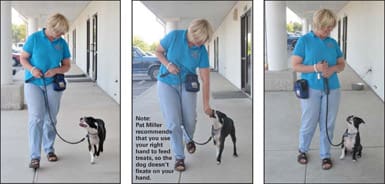
385
Technique
I’ll leave you with a final word or three on technique:
- Remember to click for behavior (Click! That behavior just earned you a treat!) and feed for position. If, for example, you’re shaping “Heel” in the early stages, you may click for a behavior that’s still far from perfect heel position, but if you feed the treat at the side of your left knee, you’ll encourage your dog to stay closer to that perfect spot.
- Many trainers carry their treat in the left hand to encourage left-side walking. This is actually a bit of luring, and makes it harder to eventually fade out the presence of the treat. I prefer to hold treats in my right hand (leash in my left) with my hand out of sight behind my right hip, and deliver across my front to the side of my left knee after I click. This way your dog has to think about where he needs to be to earn the click, not just follow the tempting scent of the treat in your left hand.
- I don’t generally wear a treat bag; I prefer to wear loose clothing where I can stash bags of treats in pockets. A treat bag is a flashing neon sign to your dog that now he has the opportunity to earn treats. I’d rather my dogs know they may be reinforced at any time, not just when I’m wearing the bag.
- Vary your reinforcers. As the late positive trainer Patty Ruzzo frequently said, be variable and unpredictable. Don’t always make it about food treats. If your dog never knows when, where, or how you might reinforce him, he has to stay attentive to you; he won’t want to miss anything! My personal choice is this: If I click my dog gets a food treat; if I use some other reinforcer I use my verbal “Yes!” marker. Now, go walk your dog!
Thanks to Sarah Richardson, CPDT-KA, CDBC, of The Canine Connection, in Chico, California, for modeling the techniques discussed in this article.
Pat Miller, CPDT-KA, CDBC, is WDJ’s Training Editor. Miller lives in Fairplay, Maryland, site of her Peaceable Paws training center. Pat is also author of The Power of Positive Dog Training; Positive Perspectives: Love Your Dog, Train Your Dog; Positive Perspectives II: Know Your Dog, Train Your Dog; and Play with Your Dog.



